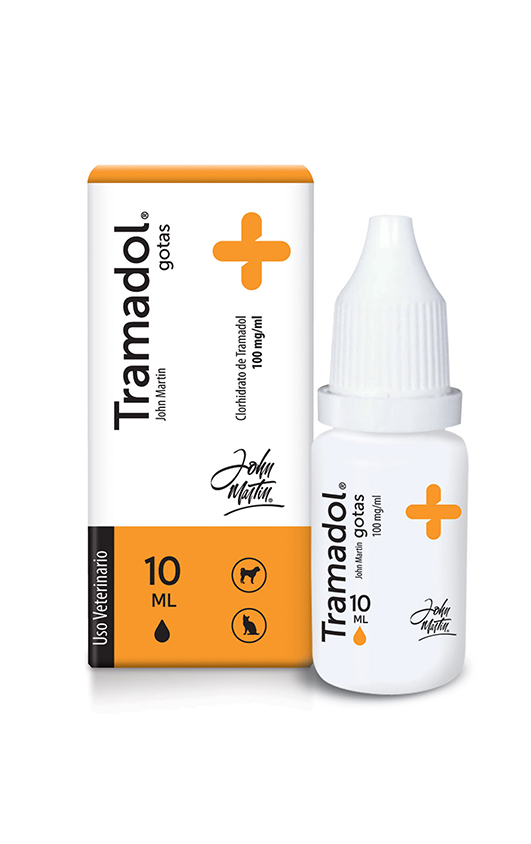ANALGESICS
Tramadol oral solution
Tramadol oral solution

Presentation:
Dropping bottle containing 10 mL.
Species:
Composition
Tramadol hydrochloride 100 mg
Excipients q.s. 1 mL
Excipients q.s. 1 mL
Therapeutic Action
Opioid analgesic drug.
Indications for Use
To be used in dogs and cats to alleviate moderate-to-severe pain caused by different etiologies.
Used to alleviate pain in acute trauma, to alleviate chronic pain and pain refractory to other treatments. Used in cancerous conditions and to treat osteoarticular and muscular pain, visceral pain in general, urologic syndrome in different species, post amputation syndrome, “phantom limb”.
To treat postoperative pain (due to its low potential to induce respiratory depression, it can be recommended as first-choice drug to treat postoperative pain instead of morphine).
Used to alleviate pain in acute trauma, to alleviate chronic pain and pain refractory to other treatments. Used in cancerous conditions and to treat osteoarticular and muscular pain, visceral pain in general, urologic syndrome in different species, post amputation syndrome, “phantom limb”.
To treat postoperative pain (due to its low potential to induce respiratory depression, it can be recommended as first-choice drug to treat postoperative pain instead of morphine).
Route of Administration
Oral
Dosage and Instructions for Use
The product shall be administered orally. Dogs and cats: administer 1-3 mg/kg body weight 2 to 3 times a day (100 mg = 30 drops=1ml). Duration of treatment will be determined by the prescribing veterinarian.
Contraindications / Warnings / Precautions
Do not use in patients with known hypersensitivity to tramadol or to any of the excipients.
Do not use in pregnant or lactating animals.
Simultaneous administration with deprenyl or with psychotropic drugs such as serotonin reuptake inhibitors, tricyclic antidepressants or monoamine oxidase inhibitors may increase seizure threshold. If administered in combination with drugs which are enzymatic inductors, such as carbamazepine, phenobarbital, phenytoin or rifampin, the dose of tramadol should be increased.
Inhibitors of isoenzyme CYP 2D such as amiodarone, cimetidine, clomipramine and haloperidol may decrease the metabolism of tramadol thus reducing the levels of metabolite M1 and, consequently, the analgesic effectiveness, and increasing the appearance of adverse reactions.
Tramadol is contraindicated in patients with respiratory depression, acute obstructive pulmonary disease, uncontrolled epilepsy and acute renal and/or hepatic failure. In patients with liver cirrhosis, the dosing interval shall be reduced. In patients with chronic renal and/or hepatic failure the dosing interval shall be increased.
Tramadol can cause miosis which may mask the presence or exacerbation of clinical features of intracranial hypertension.
Adverse reactions are rare. The most frequent ones include: gastrointestinal malaise such as nausea, vomiting, constipation or diarrhea. In connection with the nervous system, nervousness, anxiety, agitation, shaking, spasticity, euphoria, deterioration in coordination, somnolence or insomnia may be experienced. In case of apparent sedation or strange behavior, the dose should be reduced.
Side effects:
It is recommended to gradually increase the dose within 3 days, in order to reduce the presence of nausea and vomiting. The administration of an antiemetic drug during the first days of treatment can also be beneficial. Observe normal aseptic precautions.
In case of overdose, somnolence, dizziness, bradycardia, dyspnea, miosis, sensory disorders and seizures may be experienced. In this cases, gastric lavage should be performed (do not induce vomiting since it may lead to aspiration pneumonia), administer naloxone (0.02 - 0.1 mg/kg body weight IM or IV, by administering ¼ of the calculated dose every 3 -4 minutes until the desired effect is reached) and also provide parenteral hydration, oxygen therapy and ventilatory support. In case of seizure, indicate diazepam.
Do not use in pregnant or lactating animals.
Simultaneous administration with deprenyl or with psychotropic drugs such as serotonin reuptake inhibitors, tricyclic antidepressants or monoamine oxidase inhibitors may increase seizure threshold. If administered in combination with drugs which are enzymatic inductors, such as carbamazepine, phenobarbital, phenytoin or rifampin, the dose of tramadol should be increased.
Inhibitors of isoenzyme CYP 2D such as amiodarone, cimetidine, clomipramine and haloperidol may decrease the metabolism of tramadol thus reducing the levels of metabolite M1 and, consequently, the analgesic effectiveness, and increasing the appearance of adverse reactions.
Tramadol is contraindicated in patients with respiratory depression, acute obstructive pulmonary disease, uncontrolled epilepsy and acute renal and/or hepatic failure. In patients with liver cirrhosis, the dosing interval shall be reduced. In patients with chronic renal and/or hepatic failure the dosing interval shall be increased.
Tramadol can cause miosis which may mask the presence or exacerbation of clinical features of intracranial hypertension.
Adverse reactions are rare. The most frequent ones include: gastrointestinal malaise such as nausea, vomiting, constipation or diarrhea. In connection with the nervous system, nervousness, anxiety, agitation, shaking, spasticity, euphoria, deterioration in coordination, somnolence or insomnia may be experienced. In case of apparent sedation or strange behavior, the dose should be reduced.
Side effects:
It is recommended to gradually increase the dose within 3 days, in order to reduce the presence of nausea and vomiting. The administration of an antiemetic drug during the first days of treatment can also be beneficial. Observe normal aseptic precautions.
In case of overdose, somnolence, dizziness, bradycardia, dyspnea, miosis, sensory disorders and seizures may be experienced. In this cases, gastric lavage should be performed (do not induce vomiting since it may lead to aspiration pneumonia), administer naloxone (0.02 - 0.1 mg/kg body weight IM or IV, by administering ¼ of the calculated dose every 3 -4 minutes until the desired effect is reached) and also provide parenteral hydration, oxygen therapy and ventilatory support. In case of seizure, indicate diazepam.
Available
- Argentina
- Uruguay
- Perú
- Panamá
- Guatemala
- Uruguay
- Perú
- Panamá
- Guatemala